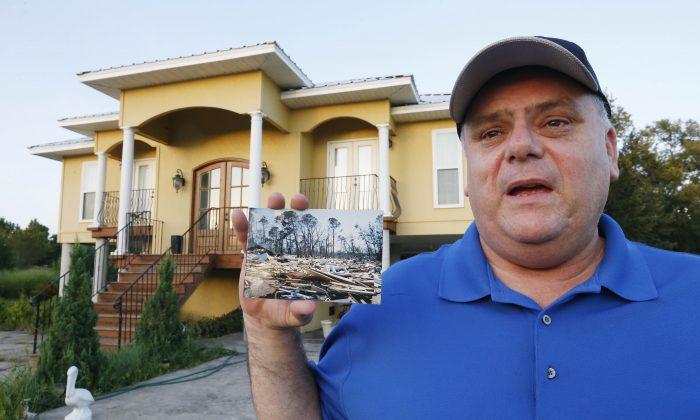LONG BEACH, Miss.—Between Mississippi’s seashore and the railroad tracks a little ways inland, where Hurricane Katrina all but erased a neighborhood 10 years ago, Efrem Garza and a handful of other homeowners are still resettling a frontier.
Once lined with houses and a small condominium complex, South Seashore Avenue in Long Beach was ravaged by wind and waves in 2005. Running from the beach highway to railroad tracks paralleling the shoreline — a zone of maximum destruction along the Mississippi coast — it was on the front lines of the storm’s fury.
Before Katrina, 10 houses and the condos stood between Garza’s house and the beach highway, U.S. 90. Now only two houses stand, giving Garza a new, clear view of the Mississippi Sound from the breakfast table in his rebuilt home.
“It’s come back very slowly,” he said.
The storm leveled Garza’s house and others near the beach, pushed a giant wall of debris halfway up the block and flooded the houses closer to the railroad track’s elevated barrier.
Empty concrete slabs from houses swept away still linger on some lots. “For Sale” signs that sprouted after the storm still dot the roadway.
While the plight of a drowning New Orleans grabbed the nation’s attention after Katrina, the Mississippi coast suffered its own deaths and destruction — and for miles, the strip between the beach and the tracks has yet to fully recover. Even a decade later, the people who lived there feel the storm’s toll.
Although the overall population of Mississippi’s three coastal counties — Hancock, Harrison and Jackson — is now larger than before the storm, in many neighborhoods closest to the water the overgrown lots and empty slabs speak to a much slower recovery.
Across Mississippi’s coast, one study found Katrina seriously damaged or destroyed more than 50,000 houses and apartments. In much of Harrison County, which includes the larger cities of Gulfport and Biloxi, the crucial line dividing the damage was the CSX train tracks. More than 1,000 houses were destroyed or severely damaged in Long Beach, along with more than 1,000 apartments. Long Beach Mayor Billy Skellie counts only two or three structures north of the tracks damaged enough to be demolished.
Unlike Garza, many former residents didn’t return, stung by their losses and spurning the gritty rebuilding struggle that followed. Beachside areas are awash in lots for sale, but potential newcomers face expensive challenges, including mandates to elevate homes and steep costs of insurance against water and winds. A federal buyout program for surplus lots has stalled because Congress hasn’t appropriated money.
“I finally said ‘No, I don’t think I want to go back,’” said Elaine Brock, who lost her husband John Noucher to Katrina. “The few people I did know there weren’t going back, and it just seemed like too much of a ghost town.”
Brock, whose married name then was Noucher, was in Florida for a doctor’s appointment and couldn’t persuade her husband to flee before the storm. She spoke to him one last time by phone on that Monday morning, advising him to huddle in an interior laundry room. When she and her son returned, they found their two dogs, but not John. His body was eventually found in the remains of a neighbor’s house, six doors north, and identified by his pacemaker. Noucher’s death certificate says only, “Hurricane Katrina Related Fatality.”
Noucher was one of five people who died in Long Beach, and one of 238 Katrina deaths counted by Mississippi officials.
Brock, who has since remarried, sold the lot in 2007, for what she called a “very low price.”
It remains vacant today.
Even those who lost no loved ones paid a heavy toll in the months after Katrina, forced to seek shelter with relatives or friends or in faraway motels and apartments. Some never bothered to pick through the rubble. Others who returned still grieve.
“My brothers are dead and they left us a bunch of stuff, and I'd lost it too,” said Robert Pickett, briefly sobbing as he recounted the aftermath. He said it was even harder on his wife, Carolyn.
“It was probably the biggest trauma in our lives and it was difficult to deal with,” Pickett said. “I was an orphan and I had been passed around and I was pretty hardened to adversity. But she wasn’t.”
Rayetta Tanguis and her siblings still own the house on South Seashore that belonged to her mother, Viola Conner. She bought it before retiring from New Orleans in the late 1980s. Farther north than the Noucher or Pickett houses, it withstood the storm but flooded with four-and-a-half feet of water. Tanguis said her mother returned to Long Beach and lived in a FEMA trailer, but died in December 2006 at age 82 before volunteers finished renovating her house.
“It just got to be too much for her, Tanguis said. ”That’s what happened to a lot of people who were in their 80s.”
Yet some, including Long Beach Alderman Gary Ponthiuex, overcame the obstacles and reclaimed their homes.
“You need a certain type of strength somewhere down deep,” Ponthieux said.
Ponthieux and his son fled the storm atop the railroad track after their home began to disintegrate. Despite his losses, there was never any question he would return.
“This is home,” Ponthieux said. “What else are you going to do?”
He and other neighbors drew from $1.9 billion in federal grants that Mississippi gave to homeowners who lacked flood insurance or needed additional aid.
Like almost everyone who rebuilt, Ponthieux has downsized. His house is about a third smaller than the 3,200 square feet he had before the storm.
That’s partly because it costs more to build elevated structures, as is now required.
Insurance costs more now, too. For a federally backed flood insurance policy, a state-backed wind insurance policy and a private policy covering the remainder of homeowners’ risks, Ponthieux said he pays $4,600 a year, compared to $1,600 before the storm. Wind insurance policies, after a steep climb, have leveled off or even declined a little. Congress canceled steep increases in flood insurance for some policyholders in 2014, but rates continue rising significantly.
Pickett said he’s now going without insurance, an option for people without a mortgage.
“The kids will be upset. That’s all,” said Pickett, 80, of any future loss. “Considering our age, we decided it’s not worth it.”
The returning homeowners have been joined by a trickle of newcomers like homebuilder Chris Patrick, who just completed a house overlooking the beach and hopes to build more. Like many other South Seashore residents, Patrick said he loves living near the water, and he’s willing to risk another storm.
“For me, the view is what I paid for,” Patrick said, standing on a porch elevated high above ground.
But he said it cost almost twice as much to build his new house 17 feet in the air as it would have cost on the ground.
“I don’t think I could do it any cheaper,” he said of the house, which he’s trying to sell for $350,000. “It’s expensive just to get the Sheetrock up this high.”
Some, including Jackson-area auto dealer Mike Cox, would like to build new houses but say the costs of elevation and insurance are holding them back. Cox bought a lot in 2014, with plans for a three-bedroom house.
“They said it had to be 15 to 20 feet off the ground. It had to withstand 150 mph wind. Then you talk about trying to insure it,” Cox said, “It’s not that I don’t have the money to do it, it’s just that I don’t want to do it. I don’t want to take the chance.”
Others can’t sell their property. Paul Kraber of Yorkville, Illinois, is trying to avoid a “fire sale” of his lot after losing his house on South Seashore, saying he needs the money because he didn’t recover the full value of the house from his insurer. A small “For Sale” sign brings occasional calls, but no one wants to pay his $50,000 asking price. Slightly smaller lots on Buena Vista Drive, a block east, are currently listed at $19,900 and $15,000.
“Everybody’s looking for a bargain and I don’t blame them,” Kraber said. “I didn’t get it as a bargain.”
Long Beach sometimes cuts vegetation to keep lots from getting overgrown and collects the cost on tax bills. The city is now requiring owners to remove remaining empty slabs from destroyed structures.
“If lots were like this, cleared, with the grass growing, we'd have a better chance of selling it, Ponthieux said. ”It’s been 10 years. It’s time for it to come up.”
One buyer could be the federal government. The U.S. Army Corps of Engineers won Congress’ approval last summer for a post-Katrina improvements program along the Mississippi coast, including property buyouts in hazardous areas. But Congress has not appropriated the estimated $413 million needed.
Still, program manager Susan Rees said 850 people have sent notice that they’re willing to sell. The goal is to buy out areas prone to flooding and storm surge, and prevent rebuilding there.
The Corps did buy a marshy area near the Alabama state line for $6 million. It will be turned over to Mississippi as a coastal preserve.
Rees suggested that rebuilding along Mississippi’s waterfront has been slow because Katrina showed people the true dangers of living there.
“I think we just have a much more educated populace as to the actual risk and the ability to ameliorate that risk,” she said.
But on South Seashore, if there’s one common thread between those who left, those who returned and those who want to move there, it’s how much they’re attracted to the water.
“It’s just home,” said Marilyn Petermann, who lives next door to Ponthieux. “I love the beach and everything. I love the water, but now I tell it, ‘You stay out there.’”
For now, that’s where it’s staying. At the end of the street, the Mississippi Sound laps softly at the beach, summoning those willing to chance a hurricane’s destructive power.





